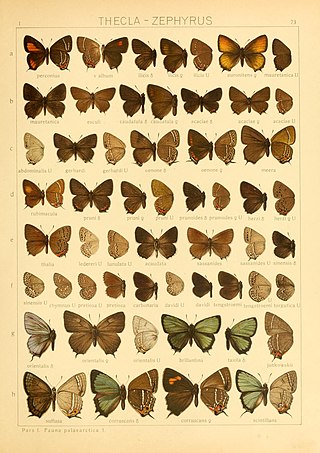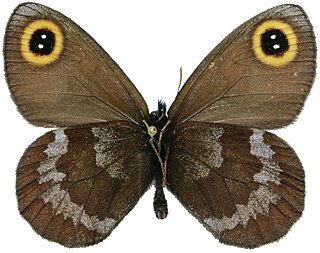
The dark green fritillary is a species of butterfly in the family Nymphalidae. The insect has a wide range in the Palearctic realm - Europe, Morocco, Iran, Siberia, Central Asia, China, Korea, and Japan.

Scolitantides orion, the chequered blue, is a species of butterfly in the family Lycaenidae. It is found in Europe, Russia and east across the Palearctic to Japan.

Parnassius tenedius, the tenedius Apollo, is an east Palearctic member of the snow Apollo genus (Parnassius) of the swallowtail family (Papilionidae). Populations range from Siberia and the Far East of Russia to the western Chukchi Peninsula, Mongolia and north China. The larva feeds on Corydalis species. In the northern part of its range it is a low altitude butterfly; further south it is montane.

Lasiommata petropolitana, the northern wall brown, is a butterfly species belonging to the family Nymphalidae. It can be found in large parts of Europe, from the Pyrenees and Alps up to Scandinavia and Finland, east to Russia and Siberia.

Lithacodia uncula, the silver hook, is a moth of the family Noctuidae. The species was first described by Carl Alexander Clerck in 1759. It is found in the Palearctic realm.

Boloria freija, the Freija fritillary, is a butterfly of the family Nymphalidae with a circumboreal distribution. It occurs in bogs and tundra. Its range includes Northern Europe to the north of 60° N, occasionally more southern locations, the Urals, Siberia, the Russian Far East, mountains of northern Mongolia and Hokkaido, as well as North America, extending in the Rocky Mountains to 35° N.

Boloria polaris, the Polaris fritillary, is a butterfly of the family Nymphalidae. It is found in northernmost Scandinavia, North America and in Greenland. It is also found in northeastern Russia and across the Palearctic to Chukotka. It is one of only six butterfly species found on Canada's Ellesmere Island.

Euxoa recussa is a moth of the family Noctuidae. The nominate form is found in mountainous areas in Southern Europe as well as the Alps. Euxoa recussa tetrastigma is found Northern Europe, east to Russia, Western Siberia, the Altai Mountains and Amur.

Diarsia dahlii, the barred chestnut, is a moth of the family Noctuidae. The species was first described by Jacob Hübner in 1813. It is found in Europe, through the Palearctic east to the Kamchatka Peninsula, northern China and Japan.

The shoulder-striped clover is a species of moth of the family Noctuidae. It is found in most of Europe, Ukraine, southern Russia and southern Siberia, Transbaikalia, Turkey, central Asia, China, Japan, the Korean Peninsula, Mongolia, northern India, Pakistan, the Russian Far East.

Athetis pallustris, the marsh moth, is a moth of the family Noctuidae. It is found in most of Europe, the southern Urals, southern Russia, Ukraine, eastern Turkey, Siberia, the Amur region, the Russian Far East, Mongolia and northern China.

Neolycaena rhymnus is a butterfly of the family Lycaenidae. It is found from Ukraine and southern and central Russia to the southern Ural mountains, Zauralye, the western and southern Altai Region, the Sayan mountains and Kazakhstan. Seitz gives this description - T. rhymnus Ev.. Tailless, the wings brown above and beneath. The underside irrorated with numerous white short dashes, which are partly placed in rows and partly irregularly dispersed. — In South Russia, South Siberia to the Altai, in May and June, on steppes.
Triphysa dohrnii is a butterfly of the family Nymphalidae. It is found in Russia, north-western China and Mongolia. Seitz dohrni Z., has a broader, more whitish metallic margin than phryne. The habitat consists of mountainous steppe up to altitudes of 2,400 meters.

Triphysa phryne is a butterfly of the family Nymphalidae. It is found from southern Ukraine to the Altai. The habitat consists of steppe and semi-deserts.

Erebia cyclopius is a species of butterfly of the subfamily Satyrinae in the family Nymphalidae. It is found through Siberia, northern Mongolia, northern China and North Korea. The habitat consists of forest edges, flowery meadows and sparse larch forests.

Boloria selenis is a species of butterfly in the family Nymphalidae. It is found from the Volga basin to Japan.

Tongeia fischeri, or Fischer's blue, is a butterfly of the family Lycaenidae. It was described by Eduard Friedrich Eversmann in 1843. It is found in south-eastern Europe, the southern Ural, northern and eastern Kazakhstan, south-western and southern Siberia, the Russian Far East, Mongolia, China, Korea and Japan.

Erebia discoidalis, the red-disked alpine, is a member of the subfamily Satyrinae of family Nymphalidae. It is found in North America from eastern Quebec, through northern Ontario, and the northern Prairies to northern British Columbia, the Northwest Territories, Yukon, and Alaska. It reaches just into the northern U.S. between Michigan and Montana, and also occurs in Asia, where it has been recorded from the Chukot Peninsula to the eastern Sayan Mountains and Amur. The habitat consists of large, open, grassy bogs and other areas with acidic soils.

Coenonympha amaryllis is a small butterfly found in the East Palearctic that belongs to the browns family.

Patricius lucifer is a butterfly found in the East Palearctic that belongs to the blues family.



















